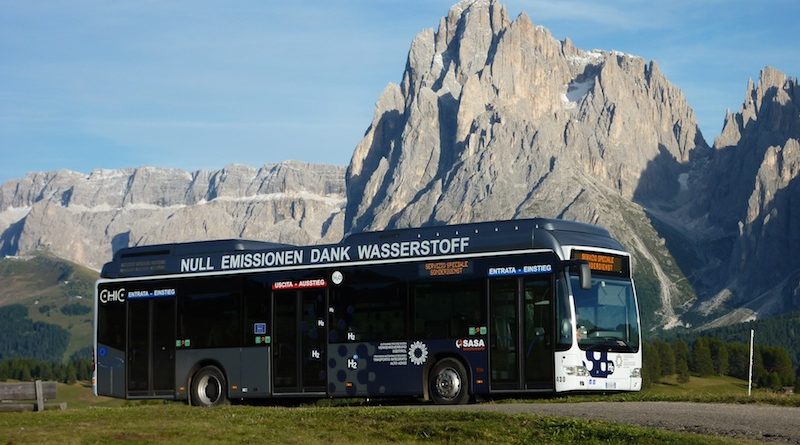
The role and place of hydrogen in today’s mobility
All over the globe, leaders are looking at strongly addressing climate change.
In December 2018 in Katowice, the COP 24 signed off the “rulebook” needed to bring the Paris Agreement to life which aims at keeping global warming well below 2°C compared to pre-industrial levels.
The adopted guidelines package will be instrumental to encourage the uptake of actions fighting climate change.
In this context, transport has a key role to play. Decarbonising transport is becoming a pressing challenge at European level as this sector accounts for the largest share of CO2 emissions with 27%, a rising figure unlike other sectors.
In parallel, there is a growing pressure to improve citizens air quality with the European Commission opening infringement procedures towards some Member States for breaching EU rules on air pollution limits.
It is urgent to act now and fuel cell electric vehicles (FCEV) provide a solution to tackle the big challenges Europe is facing in the transport sector: decarbonisation and air pollution. FCEVs offer zero tail-pipe emission as well as allow for a driving style similar to conventional engines, with large range and quick refuelling time (less than 5 minutes), thus no need to change drivers’ habits.
How does it work? Simple: a fuel cell is used to convert hydrogen in electricity to power the electric engine.
Several examples are already present in the transport sector throughout Europe showcasing the maturity of this technology.
Concerning cars, given the remaining high upfront cost of the infrastructure and of the vehicles, we see first fuel cell electric cars in captive fleets such as taxis.
An example is the hype taxi scheme in Paris: over 100 taxis drive long hours without refuelling needs, no loss in productivity and the hydrogen refuelling station, located at the Paris Orly airport, is used optimally at full capacity creating a business case for the infrastructure.
The vehicles are also an excellent answer to growing new mobility types, such as private hire or car-pooling (e.g. CleverShuttle) and thus contribute to even further reduce the environmental footprint of private cars.
Hydrogen offers also an attractive rail passenger service solution like the Alstom Coralia iLint hydrogen trains that are today in commercial service in Lower Saxony, Germany.
Hydrogen-powered trains are a clean alternative to the costly electrification of lines.
This is particularly appealing in European countries with a low electrification rates. France, the United Kingdom, other German regions to name a few, intend to follow the path of Lower Saxony and invest in zero emission silent hydrogen trains.
Currently, buses, coaches and trucks, represent one fifth of the road transport emissions2 and are, so far, not regulated at European level.
This will very likely change in the near future: regulating CO2 emissions from heavy-duty vehicles will help drive zero emission vehicles forward.
Hydrogen makes sense today in heavy duty applications: hydrogen trucks offer longer range and heavier payload, as they have a high energy density per weight.
Fuel cell buses have a daily range of up to 400 kms and are currently being deployed across Europe.
The JIVE initiatives, co-funded by the Fuel Cell Hydrogen Joint Undertaking (FCH JU) under Horizon 2020 will deploy 300 buses in early 2020s in 22 cities across Europe, the largest deployment to date.
As of today, hydrogen is the most promising zero emission alternative for long haul trucks.
Here as well, things are moving in the right direction. Just to name some of the latest developments: truck maker Nikola has announced very ambitious targets in term of vehicle mileage, number of vehicles and associated hydrogen infrastructure coverage and has secured over $13 billion in pre-order reservations for its vehicles.
Additionally, Nikola is now moving into the Europe market as well with pre-orders from several EU countries (e.g. Benelux, Norway,).
Switzerland has just ordered 1,000 fuel cell trucks for the retailer company Coop.
More and more manufacturers are joining the club and working on long haul hydrogen trucks and end-users are recognising hydrogen as a key alternative to diesel for long haul transport.
Not only road and rail transport can be decarbonised with zero emission fuel cell vehicles.
Considering that maritime transport account today for 2,5% of global CO2 emissions and that these emissions are predicted to raise tremendously by 2050, there is a need to develop solutions powered with alternative fuels.
While the Energy Observer, the first hydrogen-powered vessel is touring the world to demonstrate the readiness of the technology, maritime key players are looking at hydrogen powered vessels from catamarans to large ships.
All of this cannot happen without the appropriate infrastructure.
Today some 200 hydrogen refuelling stations are operational across Europe, while new stations continue to open almost every month.
The support from the Fuel Cell and Hydrogen Joint Undertaking and the Connecting Europe Facility (CEF) has proved to be essential, while some stations are becoming commercially viable with a growing utilisation rate.
This shows that the European Union is committed to enhance decarbonising solutions like hydrogen.
In the case of hydrogen this is even truer as not only it helps zero emission in transport but also in other sectors: Hydrogen is a bridge between sectors, fundamental part of sectoral integration.
As Commissioner Arias Cañete stated recently “We are already in the process of developing a European Commission long term strategy to reduce greenhouse gas emissions. Hydrogen will be important to increase flexibility and we want to give a clear signal to industry that it makes sense to invest in sectoral integration.”, showing, one more time, the crucial cross-sectors role hydrogen is playing and will play.
Hydrogen Europe
Hydrogen Europe is the European Hydrogen and Fuel Cell Association. It currently represents more than 113 industry companies, more than 68 research organizations as well as 13 National Associations. The association partners with the European Commission in the innovation pro- gramme Fuel Cells and Hydrogen Joint Under- taking (FCH JU).
For more information, please visit www.hydrogeneurope.eu.




